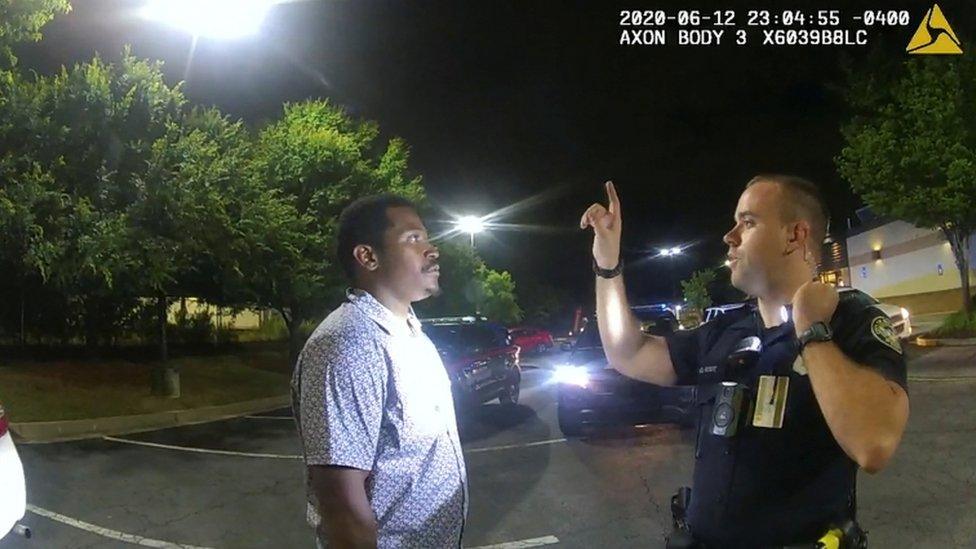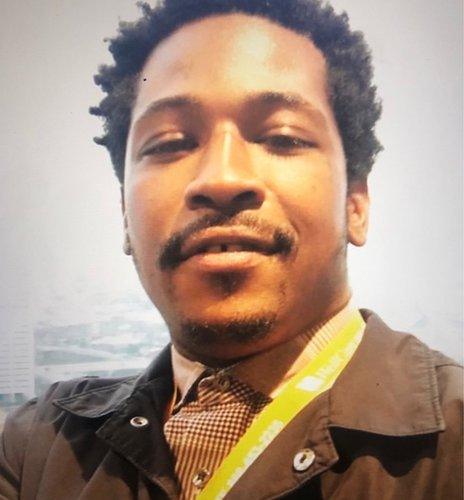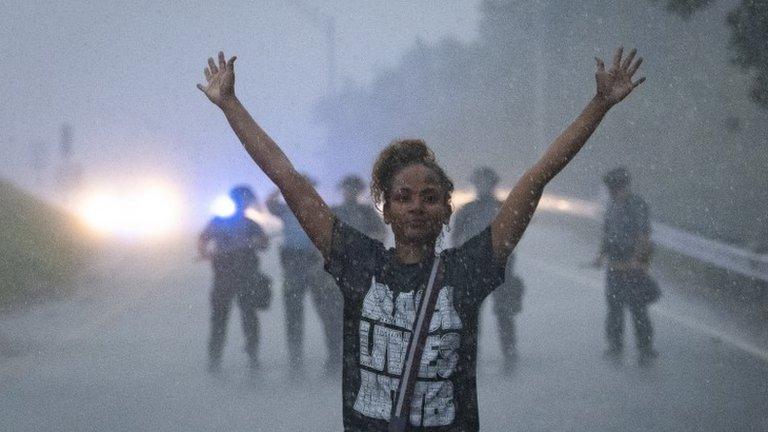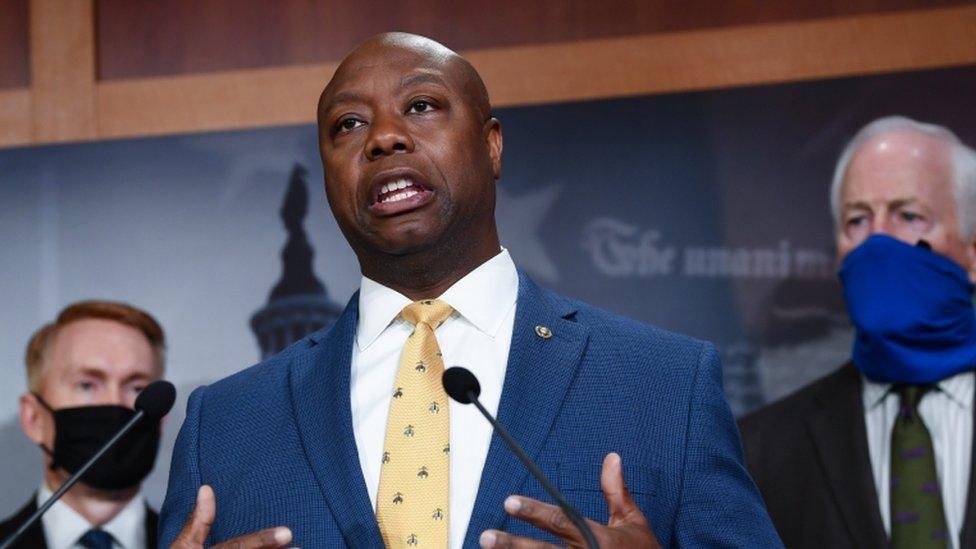Rayshard Brooks shooting: US policeman faces murder charge
- Published

Mr Rolfe conducted a sobriety test on Mr Brooks in the car park
A police officer who fatally shot a fleeing black man in the back last week in Atlanta, Georgia, will be charged with murder and assault, officials say.
Garrett Rolfe, who has already been fired, faces 11 charges related to Rayshard Brooks' death. If convicted, he could face the death penalty.
The other officer at the scene, Devin Brosnan, will testify as a prosecution witness in the case, officials said.
The case comes amid US protests over police killings of black Americans.
Lawmakers in Washington are currently debating new police reform laws.

Garrett Rolfe (left) and Officer Devin Brosnan
Officials said this was the ninth time that an Atlanta police officer had been prosecuted for homicide.
They added that it is believed to be the first time a police officer would testify against a member of his own unit, though Mr Brosnan's lawyer denied his client would be a witness in the case.
President Trump has said he is concerned about the way the case against Mr Rolfe is being handled.
"I hope he gets a fair shake because police have not been treated fairly in our country," he told Fox News.
"You can't resist a police officer like that," he added, referring to Mr Brooks' actions during the incident.
What happened?
Mr Brooks, 27, failed a sobriety test on 12 June after he was found asleep inside his car that was blocking a drive-through lane at a Wendy's restaurant.
After pulling over his vehicle, the father-of-four appeared "slightly impaired, but his behaviour during this incident was almost jovial", Fulton County District Attorney Paul Howard said on Wednesday.
For over 40 minutes, video shows him complying with officers as he consented to a weapons search and provided them with his identification details.
Rayshard Brooks' widow: "I felt everything that he felt"
However, as officers tried to handcuff him, he began struggling. The footage appears to show Mr Brooks punched Mr Rolfe, grabbed Mr Brosnan's stun gun and turned back while fleeing to fire it at Mr Rolfe.
Mr Brooks suffered two gunshots to the back that caused organ injuries and blood loss. One police bullet also hit a witness' vehicle, nearly killing the driver, investigators say.
Prosecutors said Mr Rolfe said: "I got him." For over two minutes after Mr Brooks was shot, neither officer provided medical attention as police are required to do, prosecutors said.
Instead, Mr Rolfe kicked Mr Brooks while he was on the ground, Mr Howard added.
Officer Brosnan - who has already been placed on administrative leave - will be charged with assault for allegedly standing on Mr Brooks' shoulder as he lay dying.

Rayshard Brooks (undated photo)
What else did the prosecutor say?
The district attorney said that eight videos from the scene showed Mr Brooks "displayed no aggressive behaviour during the 41 minutes and 17 seconds" that he was questioned, and posed no physical risk to the officers in that time.
Mr Brooks was 18ft (5.5m) from the officers when he was shot twice in the back, investigators say.
"I believe that at the time of the shooting, Mr Brooks did not represent a threat," Mr Howard said, noting that police rules prohibit firing a Taser at a fleeing suspect.
"So he certainly cannot fire a handgun at someone running away," he said.
How have the suspects responded?
A lawyer for Mr Rolfe blamed Mr Brooks for his choice to "violently attack" the arresting officers "suddenly, without warning or provocation".
"Mr Brooks violently attacked two officers and disarmed one of them," continued the statement issued by the LoRusso Law Firm.
"When Mr Brooks turned and pointed an object at Officer Rolfe, any officer would have reasonably believed that he intended to disarm, disable, or seriously injure him."
A lawyer for Mr Brosnan disputed the district attorney's claim that he will serve as a "state's witness", or that he has already admitted to standing on Mr Brooks as he died.
"It's absolutely untrue," lawyer Don Samuel told the Atlanta Journal Constitution newspaper.
Mr Brooks' family call for officers to serve time in jail
What has the reaction been?
The shooting came as the nation was already in uproar over the death in police custody of another unarmed black man, George Floyd, in Minneapolis, Minnesota. The four officers involved in Mr Floyd's arrest have been sacked and are facing charges of second-degree murder, or aiding and abetting murder.
The Wendy's restaurant where Mr Brooks died was burned down after about 1,000 protesters turned up there in the hours after his death. His death also led to the resignation of Atlanta's chief of police.
A lawyer for Mr Brooks' widow, Tomika Miller, told the Associated Press that he was not aware of some of the details announced on Wednesday, such as Mr Rolfe's alleged kick as Mr Brooks lay dying.
"It's heartbreaking, but it's an attempt to redefine justice," said lawyer L Chris Stewart.
The Wendy's drive-through restaurant was set on fire over Mr Brooks' shooting

Why this case is different
Analysis by Jessica Lussenhop, BBC News
The swiftness with which a white police officer has been fired and then charged with murder in the killing of Rayshard Brooks is just the latest sign of how rapidly and dramatically police agencies have shifted strategy when it comes to dealing with deadly force cases.
Historically, not only have police chiefs been reticent to take action against officers involved in in-custody deaths until a "full investigation" had taken place, they've been quick to defend the officer's use of force if he or she "reasonably" believed that a person had a deadly weapon or posed immediate danger to the officer.
In this case, video shows that Brooks had taken the officer's Taser and appears to use it. But not only is the weapon designated as less than lethal, the video shows he was running away and that the shots that killed him entered his back.
Now the officer faces 11 charges, the question of whether or not a Taser should be considered a deadly weapon will surely come into play, as well as whether the officer had "reasonable" fear of Brooks.
What is already clear is that police departments are not feeling nearly as confident relying on the old strategies and rhetoric that historically have allowed them to slow-play their response to a police-involved killing.
- Published15 June 2020

- Published17 June 2020
